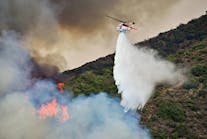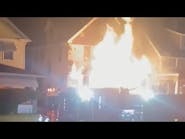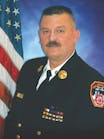SAN DIEGO, Calif. -- There was a whole lot of learning going on Sunday in preconference training sessions for Firehouse World at the San Diego Convention Center.
Firehouse presented a two-day training academy on incident command which was groundbreaking on a number of fronts. First, it was a two-day intensive class taught by top-flight fire service leaders and, second, California firefighters received continuing education credits for attending.
Coverage of Firehouse World 2011
Lead by Ed Hadfield, deputy chief of the Coronado, Calif., fire department, the intensive weekend course was aimed primarily at firefighters aspiring to become leaders in the fire service and those who have recently climbed the ladder to command.
"This is a first," said Hadfield, during a break in Sunday's sessions. "...We have a tremendous amount of past and present leadership here teaching and we've broken the class into groups relative to job function."
The attendees, who were limited to a group of 30 individuals, were enthusiastic about what they were learning and came from all over the country, including Chicago, the East Coast and all parts of California. Much of the learning was done by experiential teaching with sages of the fire service passing down lessons from their knowledge base, but much of it was also done by peers as they shared stories and their own experiences.
Hadfield said much of Saturday's lessons were lecture with various instructors giving presentations throughout the day. Sunday, however, was a little different than the norm with students breaking into "peer groups." Those groups were organized by the roles and jobs they have within the fire service and each was rotated through four instructors who focused on scenarios they might likely face in their careers.
Discussion: Just Cause
One such breakout group was lead by Gary Lane, division chief of the North County Fire Protection District in San Diego. In a roundtable discussion with about 10 firefighters, Lane tackled the topic of just cause and how it relates to disciplining employees.
"We do a bad job in the fire service explaining what just cause is," Lane said. "As a firefighter, I knew I could be disciplined for just cause and I knew as a fire officer that I could discipline firefighters for just cause, but didn't really understand what it meant."
For the next 45 minutes, Lane set about teaching the students the ins and outs of just cause and how it would relate to their employment as a fire officer.
He outlined seven steps of just cause which pivoted on the need to have documentation of the offense, actions taken to correct the unacceptable behavior, review of the rules to make sure they are just and worthy and then enforcement consistency in the department.
The last point Lane drove home is that, "The punishment has got to fit the crime."
Lane also cautioned that as a fire officer, fire leaders have to carefully balance the desire to be a buddy with the need to be the boss.
"You have to be honest and nip the behavior in the bud," Lane said. Firefighters shared their own examples of times they have witnessed, or heard about, discipline with just cause in their departments and also did a bit of role playing.
Discussion: Scene Size-Up
Concurrently, Mike Alder, battalion chief of the San Bernardino City, Calif., Fire Department, was conducting a breakout session on scene size-up for first due company officers, particularly captains whose initial thoughts about a fire scene can make a huge difference in safe operations and final outcome.
"A good size-up makes a good foundation for all future operations," Alder said.
Many of the instructors, including Alder, were using computer programs that allowed the teacher to show smoke and flames issuing from different structures to create scenarios to which the students reacted.
One of Alder's interactive slides was a large single-family home with moderate to heavy smoke showing from what appeared to be a second-story bedroom window.
"This fire isn't a big deal, but how we handle it could turn into a very big deal," Alder said.
One by one, each of the firefighters described what they saw and how they would react to the situation if it was their fire.
Alder stressed the importance of "doing a lap" around the fire building to see all four sides to know exactly what the department was facing. "Is this going to be an offensive or a defensive mode?" Alder quizzed.
Unanimously the students said it was an offensive mode and they were going to go into it and put the fire out. He praised their decisiveness, but cautioned that sometimes, an aggressive interior attack isn't always the right call, reminding them of the adage of risk versus benefit.
"It's easy to make the calls that are black and white, but it's the ones that are a little gray that are going to bite you," Alder said.
Today, with the kinds of construction types and the materials used in contents, Alder said it might not be the best move to rush into a building and get the fire out.
He added that sometimes a good fire command requires "building a system" by calling in additional resources, and getting them in place with a plan. "And then we go in, like an Army, and put the fire out," he said.
That, however, doesn't mean that sometimes aggressive action isn't prudent, particularly when it comes to saving lives.
"We all have jobs to do and we shouldn't let the fear of liability get in the way of doing them," Adler said.
By the wrap up of the class, the students were full of praise for the instructors and the format. One student said he wished it was three days given the amount of course material that was presented and how much was left on the table, not discussed for want of more time.
Another student said that, by far, the class offered the most instruction for the money bar none.
"I'd have to pay you guys a $1,000 or $2,000 to come teach me for a couple of days," the student said.
"That can be arranged," Hadfield quipped. "I'm available."
Hadfield said he was pleased with the course and the feedback and hopes to offer it in the future, perhaps as a three-day event.
Other instructors involved with the class included Anthony Kastros, battalion chief of the Sacramento (Calif.) Metro Fire District; Wes Kitchel, captain, Santa Rosa (Calif.) Fire Department; Andy Mejia, captain, Encinitas (Calif.) Fire Department and Jeff Breasher, captain, San Ramona Valley (Calif.) Fire Department.





